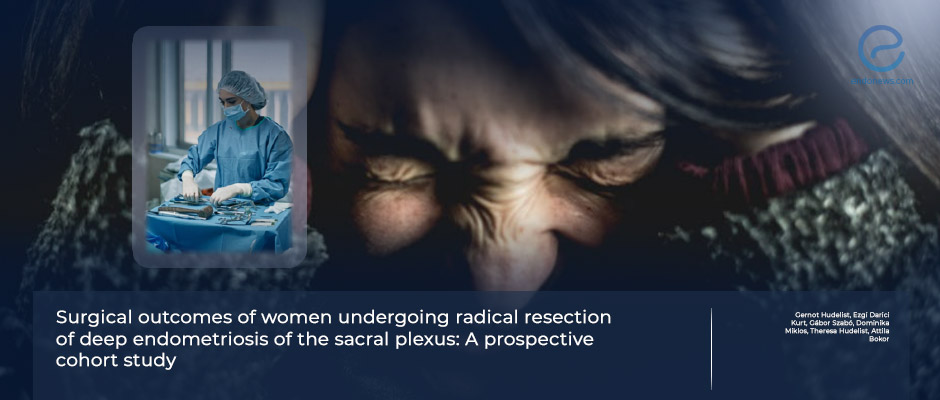Postoperative Outcomes in Women After Sacral Plexus Deep Endometriosis Resection
Dec 19, 2024
Pain and neurological symptoms of women with sacral plexus endometriosis improve significantly after radical resection resulting in increased quality of life.
Key Points
Highlights:
- Surgical resection for sacral plexus endometriosis significantly reduces neurological and pain symptoms, improving quality of life, though it is associated with considerable surgical morbidity.
Importance:
- This study is important as it demonstrates that radical resection effectively alleviates pain and neurological symptoms, enhancing the quality of life in patients with sacral plexus endometriosis.
- Surgical resection should be performed by experienced surgeons in multidisciplinary tertiary referral centers.
What’s done here?
- This multicenter, prospective cohort study assessed the outcomes of radical resection in women with sacral plexus endometriosis (SPE).
- The primary goal was to evaluate improvements in sacral radiculopathy (dysaesthesia, paraesthesia, hyperaesthesia, and pain).
- Thirty premenopausal women with histologically confirmed SPE who underwent surgical resection were included.
- Radical dissection of sacral roots and additional procedures for concomitant deep endometriosis at other anatomical sites were performed.
- All surgeries were laparoscopic and conducted by experienced surgeons at tertiary multidisciplinary referral centers.
- Major intra- and postoperative complications were also evaluated.
Key results:
- Preoperatively, dysaesthesia (43.3%), paraesthesia (53.3%), hyperaesthesia (16.7%), and secondary motor dysfunction (13.3%) symptoms were observed.
- As surgical approach, 20% (6/30) of patients required partial sacral root resection due to endometriotic infiltration, the remainder underwent dissection or shaving with cold scissors.
- Mean follow-up of 25.5 ± 20.2 months.
- Sacral radiculopathy improved in 93.1% (27/29) of patients, with significant reductions in dysaesthesia, paraesthesia, and hyperaesthesia. Pain symptoms, including dysmenorrhea, dyspareunia, and dyschezia, also decreased significantly, accompanied by a notable improvement in quality of life scores.
- In terms of morbidity, de novo hyperaesthesia was seen in 6.8% (2/29) of patients, and paraesthesia in 3.4% (1/29). Major Clavien-Dindo grade III complications occurred in 13.3% (4/30) of cases.
Strengths and Limitations:
- Strengths: This study includes the third-largest cohort of surgically treated patients with sacral plexus endometriosis.
- Limitations: The small sample size, absence of a control group, and lack of randomization are notable limitations, given the rarity of the condition.
Lay Summary
Deep endometriosis refers to a severe form of endometriosis where tissue grows deeply into the pelvic and abdominal organs, including the bowel, bladder, nerves, and blood vessels. When the disease affects the sacral plexus, which is a network of nerves at the base of the spine, it can lead to severe nerve pain, known as sacral radiculopathy. This occurs when the endometriotic lesions compress, irritate, or invade the sacral nerve roots (S1-S4) or the fibers of the sciatic nerve. Women with sacral radiculopathy experience localized, sharp, burning pain (dysaesthesia), tingling sensations like electric shocks (paraesthesia), and heightened sensitivity to touch (hyperaesthesia). These symptoms significantly reduce their quality of life.
A study by Hudelist et al., titled “Surgical outcomes of women undergoing radical resection of deep endometriosis of the sacral plexus: A prospective cohort study,” published in Acta Obstetricia et Gynecologica Scandinavica, aimed to evaluate the outcomes of surgery in these women. Specifically, the study looked at the improvement in neurological symptoms and quality of life after women underwent radical resection of sacral plexus endometriosis. The study also assessed the risks of major complications during and after surgery.
The results showed significant improvements in nerve-related symptoms such as dysaesthesia, paraesthesia, and hyperaesthesia. Additionally, pain symptoms including dysmenorrhea, dyspareunia, and dyschezia (painful defecation) was notably reduced. Quality of life scores also improved after surgery. However, some patients experienced major complications, including rectovaginal fistula, pelvic abscess, and bladder dysfunction, with an overall complication rate of 13.3%.
The authors concluded that while radical resection of sacral plexus endometriosis can effectively reduce pain and neurological symptoms, the surgery carries a high risk of complications and should only be performed by experienced surgeons in specialized, multidisciplinary centers.
Research Source: https://pubmed.ncbi.nlm.nih.gov/39611222/
endometriosis deep endometriosis morbidity

